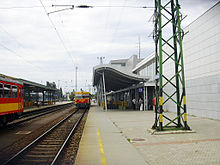| BudapestâZĂĄhony railway | |
|---|---|
| Overview | |
| Owner | MĂV |
| Line number | 100a (BudapestâSzolnok) 100 (SzolnokâZĂĄhony) |
| Termini | |
| History | |
| Opened | 1 September 1847 |
| Technical | |
| Line length | 335 km (208 mi) |
| Track gauge | 1,435 mm (4 ft 8+1⁄2 in) |
| Electrification | 25 kV AC Overhead line |
| Operating speed | 160 km/h (99 mph) |

The railway line from Budapest to ZĂĄhony via Szolnok, Debrecen and NyĂregyhĂĄza is Hungarian State Railways line 100. It is 335 kilometres (208 mi) in length and is a double-track main line with 25 kV/50 Hz electrification. The northern section, from NyĂregyhĂĄza to ZĂĄhony, is designated 100b.
From Szolnok there is a rail connection to Budapest. The Szolnok - ZĂĄhony line has become known for the so-called Fekete vonat (black train) which brings labourers to the capital and has been the scene of fights. [1]
The initial 98-km segment between Pest and Szolnok was built by the Magyar KözĂ©pponti VasĂșt (Central Hungarian Railway) and opened on 1 September 1847. [2] [3] Construction was interrupted by the 1848-49 war of independence and was resumed by the newly formed TiszavidĂ©ki VasĂșt (Theiss Railway). The Szolnok - Debrecen segment opened on 25 November 1857 and the segment from Debrecen to Miskolc via NyĂregyhĂĄza on 24 May 1859. [2] Since January 1855, the ownership and operations-right of the section BudapestâSzolnok had been obtained by the Imperial Royal Privileged Austrian State Railway Company (StEG) in the association with constructing the section Szegedâ TemesvĂĄr. [4]
- ^ Ferenc SzlazsĂĄnszky (12 December 2003). "Fekete vonat". Hetek (in Hungarian).
- ^ a b LĂĄszlĂł KovĂĄcs (1995). Magyar vasĂșttörtĂ©net (in Hungarian). Vol. 1: A kezdettĆl 1875-ig. Budapest: KözlekedĂ©si DokumentĂĄciĂłs Kft. pp. 128 & 150. ISBN 963-552-312-2.
- ^ H. Strach (1898) p. 206
- ^ H. Strach (1898) pp. 322, 323
- Heinersdorff, Richard (1975). Die k. und k. privilegierten Eisenbahnen der österreichisch-ungarischen Monarchie 1828-1918 (in German). Wien / MĂŒnchen: Molden. ISBN 3-217-00571-6.
- Strach, Hermann (1898). Geschichte der EIsenbahnen OesterreichâUngarns. Geschichte der Eisenbahnen der Ăsterreichisch-Ungarischen Monarchie (in German). Vol. Band 1.1. Wien / Teschen / Leipzig: Karl Prochaska. pp. 73â503.
| BudapestâZĂĄhony railway | |
|---|---|
| Overview | |
| Owner | MĂV |
| Line number | 100a (BudapestâSzolnok) 100 (SzolnokâZĂĄhony) |
| Termini | |
| History | |
| Opened | 1 September 1847 |
| Technical | |
| Line length | 335 km (208 mi) |
| Track gauge | 1,435 mm (4 ft 8+1⁄2 in) |
| Electrification | 25 kV AC Overhead line |
| Operating speed | 160 km/h (99 mph) |

The railway line from Budapest to ZĂĄhony via Szolnok, Debrecen and NyĂregyhĂĄza is Hungarian State Railways line 100. It is 335 kilometres (208 mi) in length and is a double-track main line with 25 kV/50 Hz electrification. The northern section, from NyĂregyhĂĄza to ZĂĄhony, is designated 100b.
From Szolnok there is a rail connection to Budapest. The Szolnok - ZĂĄhony line has become known for the so-called Fekete vonat (black train) which brings labourers to the capital and has been the scene of fights. [1]
The initial 98-km segment between Pest and Szolnok was built by the Magyar KözĂ©pponti VasĂșt (Central Hungarian Railway) and opened on 1 September 1847. [2] [3] Construction was interrupted by the 1848-49 war of independence and was resumed by the newly formed TiszavidĂ©ki VasĂșt (Theiss Railway). The Szolnok - Debrecen segment opened on 25 November 1857 and the segment from Debrecen to Miskolc via NyĂregyhĂĄza on 24 May 1859. [2] Since January 1855, the ownership and operations-right of the section BudapestâSzolnok had been obtained by the Imperial Royal Privileged Austrian State Railway Company (StEG) in the association with constructing the section Szegedâ TemesvĂĄr. [4]
- ^ Ferenc SzlazsĂĄnszky (12 December 2003). "Fekete vonat". Hetek (in Hungarian).
- ^ a b LĂĄszlĂł KovĂĄcs (1995). Magyar vasĂșttörtĂ©net (in Hungarian). Vol. 1: A kezdettĆl 1875-ig. Budapest: KözlekedĂ©si DokumentĂĄciĂłs Kft. pp. 128 & 150. ISBN 963-552-312-2.
- ^ H. Strach (1898) p. 206
- ^ H. Strach (1898) pp. 322, 323
- Heinersdorff, Richard (1975). Die k. und k. privilegierten Eisenbahnen der österreichisch-ungarischen Monarchie 1828-1918 (in German). Wien / MĂŒnchen: Molden. ISBN 3-217-00571-6.
- Strach, Hermann (1898). Geschichte der EIsenbahnen OesterreichâUngarns. Geschichte der Eisenbahnen der Ăsterreichisch-Ungarischen Monarchie (in German). Vol. Band 1.1. Wien / Teschen / Leipzig: Karl Prochaska. pp. 73â503.